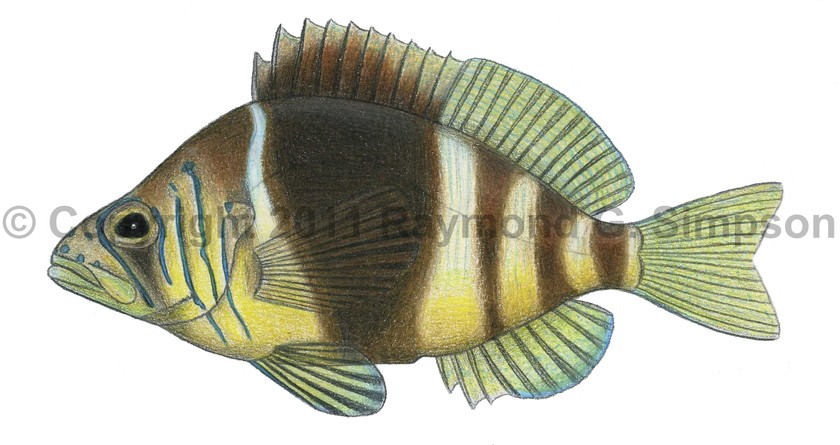
Common Name
Barred Hamlet
Year Described
Cuvier, 1828
Identification
Dorsal Fin: X, 14-15
Anal Fin: III, 7
Pectoral Fin: 13-14
Pelvic Fin: I, 5
Lateral Line: 48-53
Gill Rakers: 17-23 total
Body robust and laterally compressed. Steeply sloping head profile. Dorsal fin continuous with no obvious notch between spiny and soft portions. Anal fin much smaller than dorsal fin. Caudal fin is typically truncate to slightly emarginate. The mouth is large and terminal, with the lower jaw often slightly projecting. Jaws bear villiform teeth, with an inner band of enlarged canines. Scales are ctenoid and cover the body and much of the head. The lateral line is continuous and curves gently along the upper body.
Color
Base color of body whitish to pearly blue, becoming bright to pale yellow ventrally. There are four or five broad brown bands on the body: one immediately behind the opercle, another very wide mid-body band, a U-shaped band behind that (often broken into two bands), and a small one on the caudal peduncle. A brown triangular eye band is usually prominent. The head is covered with numerous bright blue lines and spots. The fins are yellowish in color except for the pelvic fin which is often bluish.
Size
Maximum size to 16.7cm SL.
Habitat
Coral reefs from 3-90m.
Range
North Carolina to the S. Caribbean Sea and Gulf of Mexico.
References
Lobel, P.S. 2011. A review of the Caribbean hamlets (Serranidae, Hypoplectrus) with description of two new species. Zootaxa No. 3096: 1-17.
McEachran, J.D. and J.D. Fechhelm. 2005. Fishes of the Gulf of Mexico. Volume 2: Scorpaeniformes to Tetraodontiformes. University of Texas Press, Austin. i-viii +1-1004.
Victor, B.C. 2012. Hypoplectrus floridae n. sp. and Hypoplectrus ecosur n. sp., two new barred hamlets from the Gulf of Mexico (Pisces: Serranidae): more than 3% different in COI mtDNA sequence from the Caribbean Hypoplectrus species flock. Journal of the Ocean Science Foundation v. 5: 1-19.